Volkswagen Polo Service & Repair Manual: EU Tire Label, Categories
| Rolling Resistance. Refer to
→ Anchor |
| Wet Grip. Refer to
→ Anchor |
| Noise Emission. Refer to
→ Anchor |
|
|
|
| Is defined as the amount of energy used by a tire to travel
to a given distance. |
| This corresponds to the loss of energy in units per defined
distance. |
| This is expressed as an quotient of energy in Newton meters
(Nm) and of distance in meters (m). Thus, the rolling resistance
is expressed as a force in Newtons (N). |
| The rolling resistance of a tire is defined by the rolling
resistance coefficient c R: |
| cR - Rolling resistance
coefficient |
| FR - Rolling resistance force |
| Z - Vehicle weight (sum of all wheel loads) |
| To reduce rolling resistance |
| To economize fuel and CO2 |
|
|

|
| Separated into fuel efficiency classes A to G |
 Note Note
| The fuel efficiency classes are listed in EU Regulation (EG)
1222/2009. Tires categories are established by this regulation. |
| The rolling resistance is ascertained by prescribed tests
performed by the tire manufacturer. |
| The lower the rolling resistance, the lower the fuel
consumption. |
| A - |
Lowest rolling resistance coefficient = lowest fuel
consumption |
| B - |
+ 0.10 liters / 100 km |
| C - |
+ 0.12 liters / 100 km |
| E - |
+ 0.14 liters / 100 km |
| F - |
+ 0.15 liters / 100 km |
| G - |
+ 0.15 liters / 100 km |
|
|
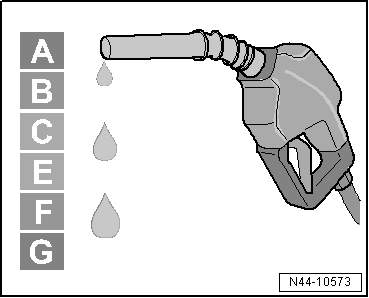
|
| For the wet grip, the wet grip parameter G must be
determined. The wet grip parameter G is defined by testing the
distance required by a standardized vehicle to brake from 80
km/h (49.7 mph) down to 20 km/h (12.42 mph) on a wet, even road
surface. The test is performed using predefined standard
reference test tires (SRTT), allowing for the wet grip parameter
G to be determined. Mean fully developed deceleration (mfdd) is
used for the test. |
| The mean fully developed deceleration is determined thusly: |
| S - the braking distance between 80 km/h (49.7 mph) and 20
km/h (12.42 mph) in meters |
| The wet grip parameter G is determined thusly: |
| |
G =
| mfdd of the
tire to be checked |
| mfdd of the standard reference tire |
|
| mfdd - mean fully developed deceleration |
| Sharp decrease in braking distance |
|
|
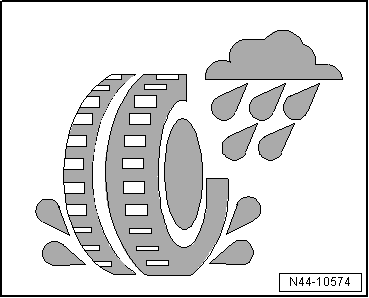
|
| Separated into wet grip classes A to G |
| Classes D and G are not used |
 Note Note
| The wet grip classes are listed in EU Regulation (EG)
1222/2009. Tires categories are established by this regulation. |
| The lower the wet grip parameter, the shorter the braking
distance. |
| A - |
lowest wet grip parameter = shortest braking distance |
| B - |
3 to 6 m longer braking distance compared to category A |
| C - |
3 to 6 m longer braking distance compared to category B |
| E - |
3 to 6 m longer braking distance compared to category C |
| F - |
3 to 6 m longer braking distance compared to category E |
| 1 - |
When emergency braking at 80 km/h (49.7 mph), the difference
between using class A and class F tires can be more than 18 m. |
|
|
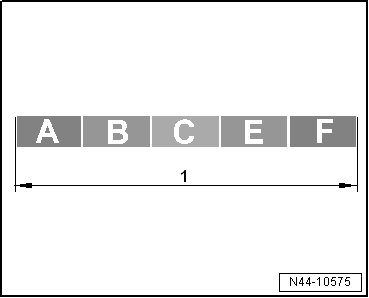
|
| Take measurements from outside of the vehicle only |
| Divided into three classes |
|
|
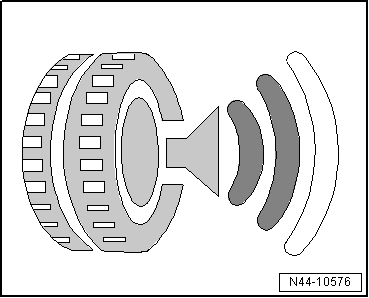
|
| Three black waves signify the worst performance. The tire
produces external rolling noise, which falls below the current
EU Directive 2001/43/EG limit. The limit surpasses the future
limit set by EU Regulation (EG) 661/2009, which will go into
effect in 2016. |
| Two black waves: the tire noise level does not exceed the
future limit set by EU Regulation (EG) 661/2009, which will go
into effect in 2016. |
| One black wave: the tire noise level does not exceed the
future limit set by EU Regulation (EG) 661/2009, which will go
into effect in 2016, by at least three decibels. |
 Note Note
| Reducing the noise measured value from two black waves down
to one corresponds to 3 dB, which halves the noise level. |
| Please note that extreme tire rolling noise does not always
correspond to the noise in the vehicle interior. |
|
|
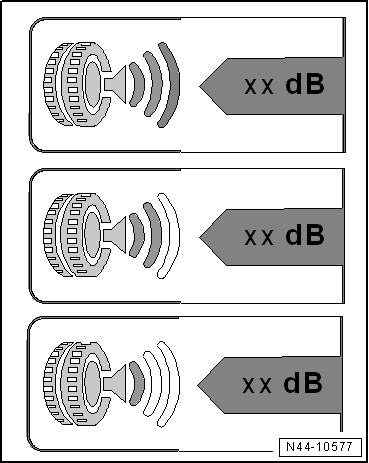
|
To reduce fuel usage
To improve road safety
To reduce traffic noise
The EU Tire Label Provi ...
Other materials:
Factory Paint Paint Structure
Structure of a Solid-Color Paint System, Conventional
Approximately 80-120 µm thick
1 -
Steel Panel
2 -
Zinc Phosphate Coating
3 -
Electr ...
Pressures, Checking
Note
Check cooling performance. The A/C system is functioning
correctly when the air flowing from the instrument panel vents
has a temperature of 70C or lower.
Setting on Climatronic “LO”.
...
Cigarette Lighter Socket, Removing and Installing
Special tools and workshop equipment
required
Cigarette Lighter Release Tool -T40148-
Note
The removal and installation for all sockets is performed in
the same way and is only described for the ciga ...
© 2016-2025 Copyright www.vwpolo.net

 Note
Note Note
Note Note
Note EU Tire Label, Goals
EU Tire Label, Goals






